Faith & Fable - Cambridge University Library - University of Cambridge
Faith & Fable - Cambridge University Library - University of Cambridge
Faith & Fable - Cambridge University Library - University of Cambridge
You also want an ePaper? Increase the reach of your titles
YUMPU automatically turns print PDFs into web optimized ePapers that Google loves.
Complex challenges: specialized<br />
solutions<br />
Many <strong>of</strong> the Islamic manuscripts in the collections are from<br />
very early times (over 80 texts date from before 1500) or have<br />
been in the <strong>Library</strong> for a considerable period. The long-term<br />
survival <strong>of</strong> these texts in a good state <strong>of</strong> repair requires a team<br />
<strong>of</strong> conservators with a thorough knowledge <strong>of</strong> the traditional<br />
materials and original methods used in their construction,<br />
and an understanding <strong>of</strong> the mechanics <strong>of</strong> their structure. This<br />
enables them to devise specific treatments that, as far as<br />
possible, preserve the objects’ original character.<br />
Islamic manuscripts are constructed using materials and<br />
techniques significantly different from their Western counterparts<br />
and therefore require unique conservation approaches. One such<br />
challenge is the deterioration <strong>of</strong> the copper-based green pigment<br />
used in the past to draw the borders set around the text on the<br />
individual pages. As this pigment ages it becomes corrosive and<br />
eats through the paper causing the text panels to break away<br />
from the page; meticulous repairs are needed to recreate the<br />
pages in their original state. Characteristically the paper itself is<br />
burnished and care must be taken to find repair materials that<br />
blend successfully with the highly polished character <strong>of</strong> the<br />
original. Another concern is that Islamic manuscripts <strong>of</strong>ten have<br />
a v-shaped flap, known as a lisān, folding over the fore-edge <strong>of</strong><br />
the volume, and this may become detached from the rest <strong>of</strong> the<br />
binding. The spine <strong>of</strong> the volume and the edges <strong>of</strong> the bindings<br />
are also prone to deterioration.<br />
Parchment pages <strong>of</strong> an early Qur’an manuscript showing water<br />
damage to several leaves. (Or.2267)<br />
The day-to-day activities <strong>of</strong> the specialist staff in the <strong>Library</strong>’s<br />
Conservation Department include controlling the environmental<br />
conditions <strong>of</strong> the storage and exhibition areas, providing book<br />
supports for items when they are in use, and even creating<br />
made-to-measure storage boxes <strong>of</strong> archival quality for Islamic<br />
manuscripts that are especially vulnerable to damage.<br />
More complex procedures are carried out on items in danger <strong>of</strong><br />
deterioration. When planning and prioritising conservation work,<br />
and deciding on the level <strong>of</strong> treatment required, it is essential to<br />
take into consideration a complicated array <strong>of</strong> factors including<br />
the existing state <strong>of</strong> the manuscript, the potential academic<br />
interest, projected usage, and time and funding constraints.<br />
Increasingly, such decisions are now made in conjunction with<br />
the need for the digitization <strong>of</strong> manuscripts, as and when funding<br />
permits. This new technology enables access to digital images <strong>of</strong><br />
the Islamic texts to be made easily available to a larger audience,<br />
and reduces the amount <strong>of</strong> handling – and the potential wear<br />
and tear – <strong>of</strong> the original manuscripts. However, ensuring the<br />
safety <strong>of</strong> historical materials during the imaging process poses<br />
fresh challenges to the conservator although the goal remains the<br />
same: ensuring that the collections are protected for the use and<br />
enjoyment <strong>of</strong> future generations.<br />
As part <strong>of</strong> the conservation process, silk gauze, added in an earlier<br />
repair process, is removed from a manuscript (Or. 1287). Tweezers<br />
are used and additional assistance is provided by a video enlarger.<br />
Left Leaves <strong>of</strong> an early Qur’an manuscript before conservation. (Or.770)<br />
35 <strong>Faith</strong> & <strong>Fable</strong>


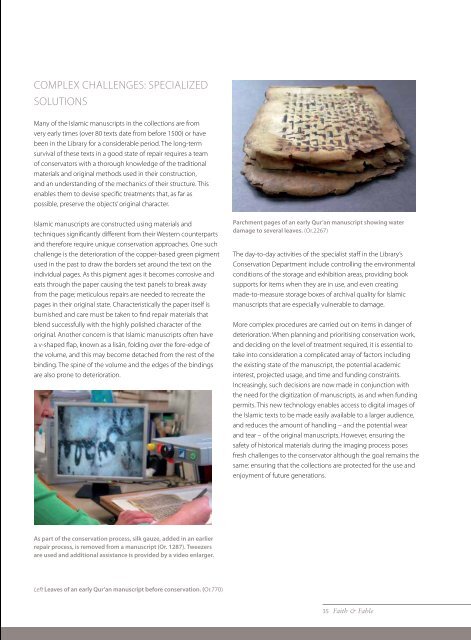
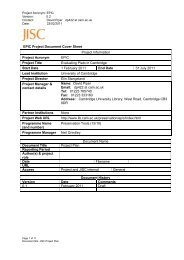

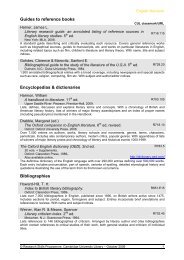
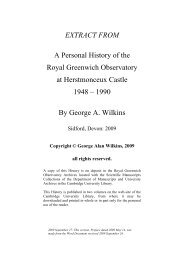
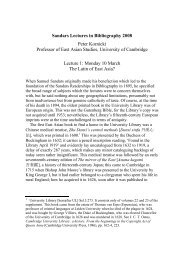
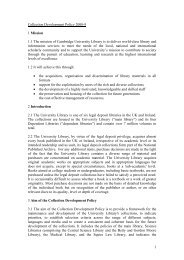

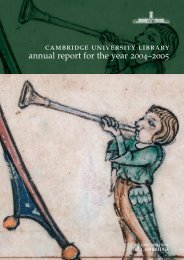

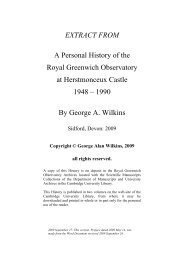


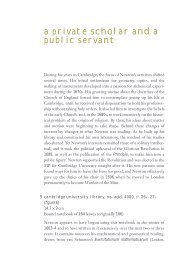

![2002-2003 [PDF] - Cambridge University Library - University of ...](https://img.yumpu.com/33538497/1/184x260/2002-2003-pdf-cambridge-university-library-university-of-.jpg?quality=85)